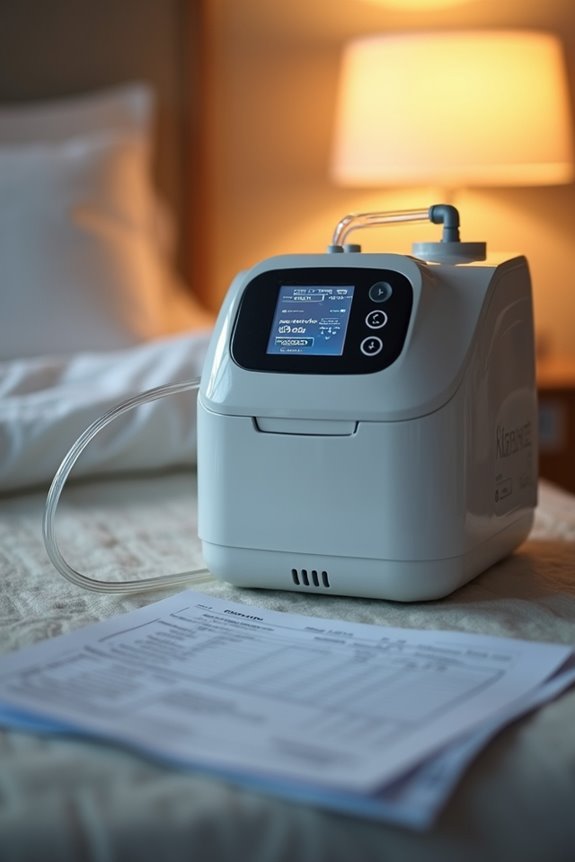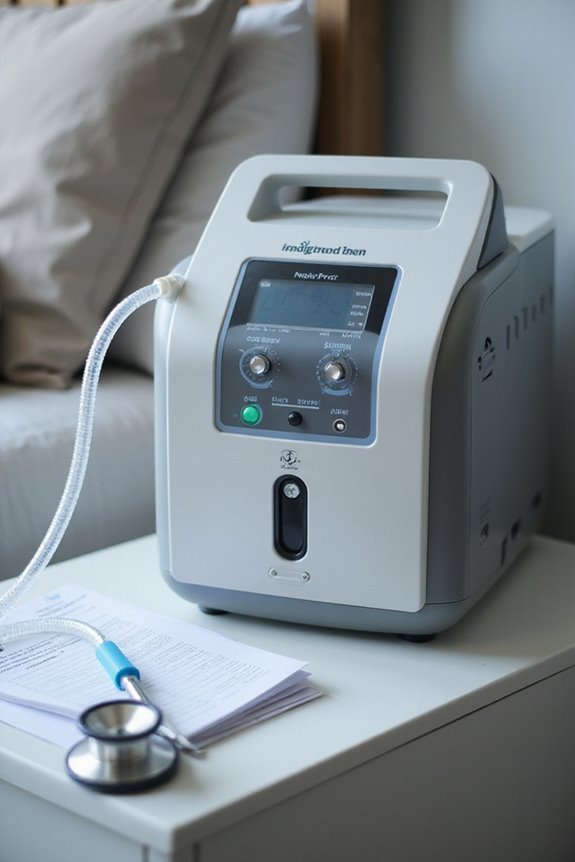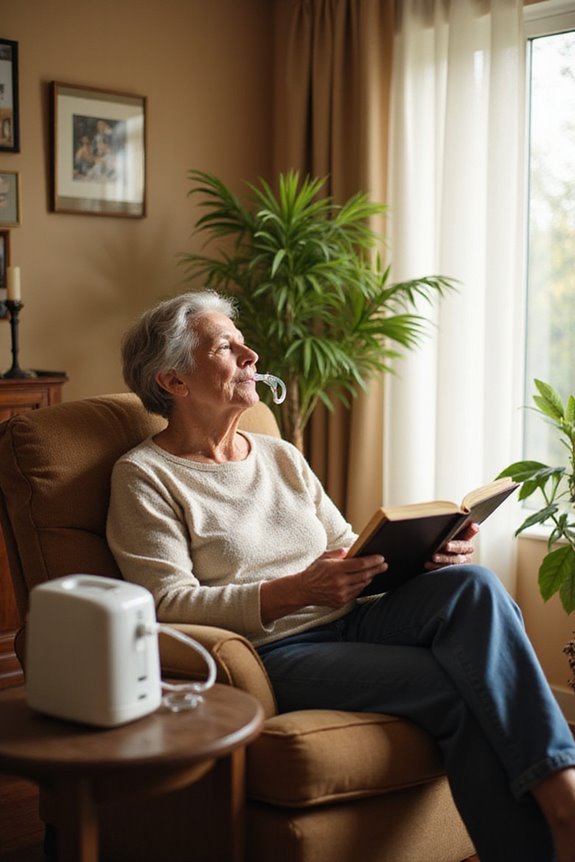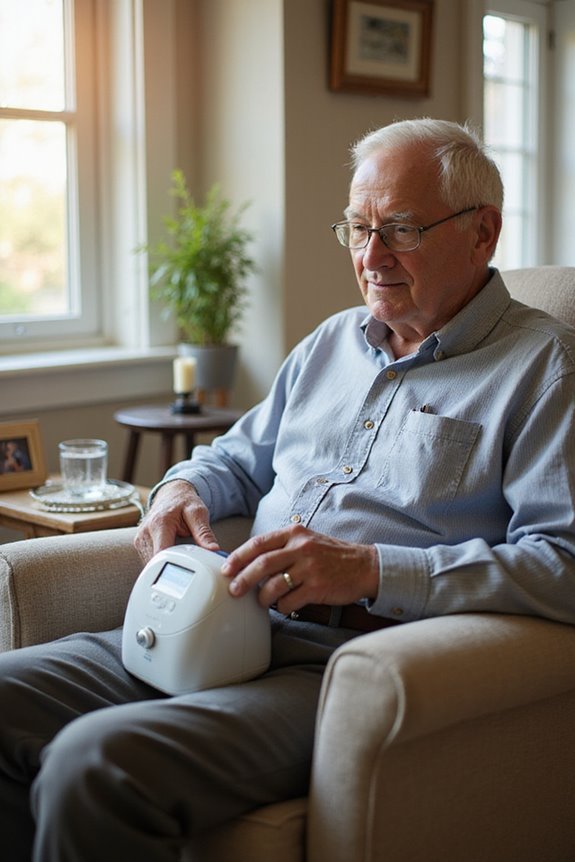A prescription is mandatory for obtaining a home oxygen concentrator. This requirement guarantees the therapy’s medical necessity and adherence to regulatory standards, such as FDA regulations. Prescriptions must specify the diagnosis, required flow rate, frequency of use, and projected duration of oxygen therapy. Additionally, the prescription is essential for insurance coverage and compliance with legal obligations. Understanding the complete process and necessary documentation can greatly enhance the overall experience of obtaining home oxygen therapy.
Key Takeaways
- Yes, a prescription is legally required for obtaining a home oxygen concentrator to ensure medical necessity and proper oversight.
- Prescriptions confirm tailored treatment plans, specifying flow rates and usage duration based on individual patient needs.
- The FDA mandates prescriptions for home oxygen devices to comply with safety and regulatory standards.
- Medical documentation, including a Face-to-Face Evaluation, is necessary to obtain a prescription and insurance coverage for oxygen therapy.
- Insurance providers, including Medicare, often require physician certification to cover the costs of home oxygen therapy.
Understanding Home Oxygen Concentrators
Home oxygen concentrators are essential medical devices designed to provide a continuous supply of purified oxygen to individuals with respiratory conditions. These devices function by extracting oxygen from the surrounding air and filtering it to deliver a consistent oxygen supply.
Key components include:
- Compressor: Moves air through the system.
- Filter: Purifies the extracted oxygen.
- Delivery System: Guarantees oxygen reaches the patient effectively.
Home oxygen concentrators can be used during daily activities or while asleep, guaranteeing patients receive adequate oxygen levels. They require a reliable electrical power source for peak functionality. Safety features, such as alarms for power failure, further enhance their reliability. Overall, these devices play a critical role in managing respiratory health, greatly improving patients’ quality of life. Furthermore, many models offer adjustable flow rates to accommodate varying patient needs.
Importance of a Prescription

A prescription is essential for the effective use of oxygen concentrators, as it guarantees that the device is utilized in accordance with the patient’s specific medical needs.
Prescription Benefits:
- Verifies medical necessity for oxygen therapy, vital for insurance coverage.
- Confirms tailored treatment plans based on individual needs, like flow rates and duration.
Patient Safety:
- Specifies correct flow rates and usage duration, reducing the risk of adverse effects.
- Prevents misuse by affirming compliance with medical directives.
Regulatory Compliance:
- Aligns with FDA regulations requiring prescriptions for medical devices.
- Provides documentation of the patient’s diagnosis and therapy need for insurance audits.
Legal Regulations Surrounding Oxygen Therapy

Legal regulations surrounding oxygen therapy are integral to ensuring the safe and effective use of oxygen concentrators. These devices are classified as regulated medical equipment, adhering to standards such as ISO 10083, which mandates specific oxygen concentration levels.
Key points include:
- Regulatory bodies, like the FDA, oversee certification and compliance, ensuring ongoing safety through regular inspections.
- Legal ramifications exist for non-compliance, including product recalls and penalties for manufacturers.
- Prescriptions are legally required for oxygen concentrators, ensuring proper oversight and dosage for patients.
- Suppliers must match equipment to prescriptions, fulfilling both medical and legal obligations.
- Additionally, safety features are essential in maintaining device functionality and protecting patient health.
Adherence to these regulations is essential in maintaining regulatory compliance and safeguarding patient health.
Medical Documentation Requirements

What documentation is necessary to guarantee compliance with medical requirements for oxygen therapy? Adhering to stringent documentation standards is essential.
- Written Order Prior to Delivery (WOPD): This must include the beneficiary’s name, item identification, prescribing practitioner’s NPI, and their signature with a date.
- Face-to-Face Evaluation: An in-person assessment by a qualified practitioner is mandatory. Documentation must confirm this evaluation, including a legible signature and exam date.
- Medical Records: These should demonstrate coverage criteria, including significant hypoxemia and supporting test results.
- Certificate of Medical Necessity (CMN): Form CMS-484 must be completed and supported by contemporaneous medical documentation.
Failing to meet these evaluation criteria can result in denial of coverage. Thorough documentation is imperative for successful claims processing.
Role of Healthcare Providers in Prescribing Oxygen

How do healthcare providers guarantee that patients receive appropriate oxygen therapy? The process begins with thorough patient evaluation, where providers assess respiratory conditions, such as hypoxemia and hypoxia. Specialized physicians, commonly pulmonologists, conduct diagnostic tests like pulse oximetry and arterial blood gas tests to determine oxygen needs.
Key aspects of treatment customization include:
- Recent patient examination, typically within a month.
- Detailed diagnosis outlining the necessity for oxygen therapy.
- Tailored prescriptions specifying flow rates and usage schedules based on individual requirements.
Healthcare providers integrate test results and collaborate with specialists to secure ideal treatment. Continuous monitoring and adjustments based on patient response are essential, fostering a holistic approach to oxygen therapy that meets diverse patient needs effectively.
Insurance and Medicare Coverage Guidelines
Understanding the insurance coverage guidelines for home oxygen concentrators is essential for patients in need of oxygen therapy. Medicare Part B provides coverage for oxygen therapy if deemed medically necessary by a physician, including both stationary and portable oxygen concentrators.
Key points include:
- Coverage requires physician certification and periodic recertification based on blood gas studies.
- Medicare typically pays 80% of the rental costs; patients are responsible for a 20% coinsurance.
- Coverage lasts for 36 months, extendable up to 5 years with ongoing medical need.
- Equipment must come from Medicare-approved suppliers to qualify for insurance benefits.
- Patients should verify coverage limits with their insurance plans, including any additional benefits offered by Medicare Advantage plans.
Clinical Indications for Oxygen Therapy
Clinical indications for oxygen therapy are guided by the patient’s oxygen saturation levels and underlying medical conditions.
Key indications include:
- Documented hypoxaemia: Defined as PaO2 < 60 mmHg or SaO2 < 90% on room air.
- Acute respiratory distress: Conditions like pneumonia and heart failure require oxygen therapy to improve saturation.
- Chronic obstructive pulmonary disease (COPD): Target saturation ranges are 88-92% during exacerbations.
- Carbon monoxide poisoning: Oxygen is administered even with normal saturation to displace carbon monoxide.
Patient assessment is critical, ensuring oxygen therapy is tailored to individual needs. Continuous monitoring of saturation levels is essential to avoid risks such as hypercapnia or oxygen toxicity, highlighting the need for precise titration in chronic respiratory failure scenarios. Additionally, oxygen purity levels are a vital factor in ensuring effective therapy and patient safety.
Patient Responsibilities in Oxygen Use
Patient Education
Patients and caregivers must receive extensive training on oxygen equipment, including proper usage and maintenance. This education covers delivery devices, flow settings, and troubleshooting common issues. Additionally, understanding safety features ensures that patients can effectively respond to any alerts or malfunctions that may occur during use.
Equipment Maintenance
Daily checks of oxygen concentrators are essential. Patients should inspect filters, tubing connections, and the power supply for functionality. Regular cleanliness protocols reduce infection risks and confirm equipment reliability.
Flow Rate Adherence
Strict adherence to prescribed flow rates is vital for effective oxygen therapy. Patients need to document usage and communicate any symptoms or equipment malfunctions to healthcare providers promptly. Regular follow-ups and refresher training help maintain compliance and safety in oxygen therapy.
Safety Considerations for Home Oxygen Therapy
Safety considerations for home oxygen therapy are paramount, as the presence of oxygen greatly increases fire risks and other hazards.
Fire Hazards
- Oxygen supports combustion, intensifying fire risks.
- Keep oxygen equipment at least 6 feet from heat sources.
- Avoid petroleum-based products near oxygen.
Oxygen Storage
- Store oxygen canisters upright in approved devices.
- Verify well-ventilated storage, away from enclosed spaces.
- Backup tanks should be secured upright or flat.
Electrical Precautions
- Do not use oxygen near electrical appliances like hair dryers or toasters.
- Turn off oxygen supply when not in use to mitigate fire hazards.
Environmental Considerations
- Use 100% cotton bedding to reduce static electricity risks.
- Maintain clear “Oxygen in Use” signs for awareness.
How to Obtain a Prescription for Home Oxygen
Obtaining a prescription for a home oxygen concentrator involves a systematic approach that guarantees the device is tailored to meet individual medical needs.
Steps to Obtain a Prescription:
- Consultation: Patients should consult a primary care physician or pulmonologist for an oxygen assessment.
- Diagnostic Tests: Blood oxygen levels are evaluated through pulse oximetry and arterial blood gas tests.
- Medical Documentation: A thorough medical history and recent examination, typically within 30 days, are necessary.
- Insurance Approval: Patients must verify specific insurance requirements for coverage.
Prescription Specifications:
- Diagnosis: Must include the disease necessitating oxygen therapy.
- Flow Rate: The required oxygen flow rate and usage frequency are detailed.
- Duration: A projected timeline for therapy is also provided.
Frequently Asked Questions
Can I Use a Home Oxygen Concentrator Without a Prescription?
Using a home oxygen concentrator without a prescription is not advisable due to medical necessity. Proper assessment guarantees safety and effectiveness, as unmonitored use can lead to serious health risks and inadequate treatment for individuals’ conditions.
What Happens if I Don’t Follow the Prescription Guidelines?
Failure to adhere to prescription guidelines presents significant health risks, including deteriorating conditions and complications. Additionally, neglecting legal implications may lead to insurance denials and potential legal repercussions, undermining both patient care and provider accountability.
How Often Should I Have My Oxygen Prescription Renewed?
How often should one renew their oxygen prescription? Following oxygen therapy guidelines, prescription frequency varies based on individual medical conditions, necessitating periodic evaluations by healthcare professionals to guarantee ideal oxygen delivery and patient well-being.
Are There Alternatives to Oxygen Therapy if I Don’t Qualify?
Exploring alternatives to oxygen therapy can include alternative therapies and lifestyle changes, such as breathing exercises, regular exercise, and dietary modifications. These approaches foster community support and promote overall health for individuals managing respiratory challenges.
Can My Doctor Prescribe Oxygen for Travel Purposes?
Like a lighthouse guiding ships, a doctor’s recommendations illuminate the path for travel oxygen needs. They assess patients, ensuring the right prescription for safe travel, allowing individuals to breathe easier while exploring new horizons.




